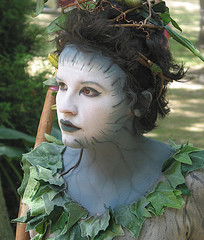Every Monday, I highlight a different Greek myth that has woven its way into the Turning Creek series. The first book, Lightning in the Dark, is out now. If you pay close attention to the details, you will see where some of the elements and history of the series originated.
You might have a vague idea of what a nymph is and I would guess your level of nerd influences your ideas about this creature. I am a nerd, so my first inclination is towards the Dungeons and Dragons version on the nymph. It is OK to admit that here.
According to the D&D Monster Manual Core Rulebook III (which I have sitting on my desk right now), a nymph is a fey and “nature’s embodiment of physical beauty.” They hate evil and can blind or kill anyone who looks at them directly with their beauty. They are solitary creatures, live in wild areas, and avoid conflict when possible. They will fight to preserve the purity and sanctity of nature. If you want to know, and I know you do, their hit die is a 3d6.

Greek mythology abounds with nymphs of all kinds. Nymphs were female spirits who ruled and protected natural and wild areas including lakes, springs, rivers, caves, clouds, trees, beaches, and fields. They cared for the plants and animals in their domain. They were not gods themselves, but were often involved with the gods and were frequent attendees to events on Olympus.
There were many classes of nymphs, which mostly depended on where they chose to live. Unlike the D&D version, Greek nymphs often lived in groups. They served as handmaidens to goddesses, had relations with the gods and bore their children, married mortals and gods alike, and served often as nurses or nurturers to gods and children.
In Turning Creek, there are a number of nymphs running around in various forms. Beth Kramer, wife of Simon Kramer, runs the mercantile with her husband and is a nymph.
